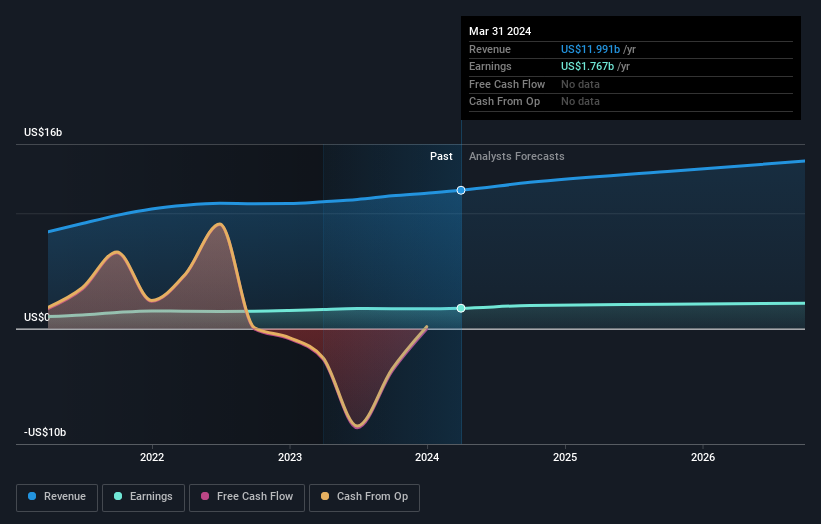- United States
- /
- Capital Markets
- /
- NYSE:RJF
Raymond James Financial, Inc. (NYSE:RJF) Second-Quarter Results Just Came Out: Here's What Analysts Are Forecasting For This Year

Raymond James Financial, Inc. (NYSE:RJF) came out with its second-quarter results last week, and we wanted to see how the business is performing and what industry forecasters think of the company following this report. Raymond James Financial reported in line with analyst predictions, delivering revenues of US$3.1b and statutory earnings per share of US$2.22, suggesting the business is executing well and in line with its plan. Following the result, the analysts have updated their earnings model, and it would be good to know whether they think there's been a strong change in the company's prospects, or if it's business as usual. So we collected the latest post-earnings statutory consensus estimates to see what could be in store for next year.
See our latest analysis for Raymond James Financial

Taking into account the latest results, the most recent consensus for Raymond James Financial from eleven analysts is for revenues of US$12.7b in 2024. If met, it would imply a satisfactory 5.7% increase on its revenue over the past 12 months. Statutory earnings per share are predicted to increase 9.6% to US$9.34. Yet prior to the latest earnings, the analysts had been anticipated revenues of US$12.7b and earnings per share (EPS) of US$9.35 in 2024. So it's pretty clear that, although the analysts have updated their estimates, there's been no major change in expectations for the business following the latest results.
There were no changes to revenue or earnings estimates or the price target of US$132, suggesting that the company has met expectations in its recent result. There's another way to think about price targets though, and that's to look at the range of price targets put forward by analysts, because a wide range of estimates could suggest a diverse view on possible outcomes for the business. The most optimistic Raymond James Financial analyst has a price target of US$141 per share, while the most pessimistic values it at US$118. Even so, with a relatively close grouping of estimates, it looks like the analysts are quite confident in their valuations, suggesting Raymond James Financial is an easy business to forecast or the the analysts are all using similar assumptions.
Another way we can view these estimates is in the context of the bigger picture, such as how the forecasts stack up against past performance, and whether forecasts are more or less bullish relative to other companies in the industry. We can infer from the latest estimates that forecasts expect a continuation of Raymond James Financial'shistorical trends, as the 12% annualised revenue growth to the end of 2024 is roughly in line with the 11% annual growth over the past five years. Compare this with the broader industry, which analyst estimates (in aggregate) suggest will see revenues grow 6.7% annually. So it's pretty clear that Raymond James Financial is forecast to grow substantially faster than its industry.
The Bottom Line
The most important thing to take away is that there's been no major change in sentiment, with the analysts reconfirming that the business is performing in line with their previous earnings per share estimates. Happily, there were no major changes to revenue forecasts, with the business still expected to grow faster than the wider industry. There was no real change to the consensus price target, suggesting that the intrinsic value of the business has not undergone any major changes with the latest estimates.
Keeping that in mind, we still think that the longer term trajectory of the business is much more important for investors to consider. At Simply Wall St, we have a full range of analyst estimates for Raymond James Financial going out to 2026, and you can see them free on our platform here..
We also provide an overview of the Raymond James Financial Board and CEO remuneration and length of tenure at the company, and whether insiders have been buying the stock, here.
New: AI Stock Screener & Alerts
Our new AI Stock Screener scans the market every day to uncover opportunities.
• Dividend Powerhouses (3%+ Yield)
• Undervalued Small Caps with Insider Buying
• High growth Tech and AI Companies
Or build your own from over 50 metrics.
Have feedback on this article? Concerned about the content? Get in touch with us directly. Alternatively, email editorial-team (at) simplywallst.com.
This article by Simply Wall St is general in nature. We provide commentary based on historical data and analyst forecasts only using an unbiased methodology and our articles are not intended to be financial advice. It does not constitute a recommendation to buy or sell any stock, and does not take account of your objectives, or your financial situation. We aim to bring you long-term focused analysis driven by fundamental data. Note that our analysis may not factor in the latest price-sensitive company announcements or qualitative material. Simply Wall St has no position in any stocks mentioned.
About NYSE:RJF
Raymond James Financial
A diversified financial services company, provides private client group, capital markets, asset management, banking, and other services to individuals, corporations, and municipalities in the United States, Canada, and Europe.
Solid track record with excellent balance sheet and pays a dividend.
Similar Companies
Market Insights
Community Narratives



